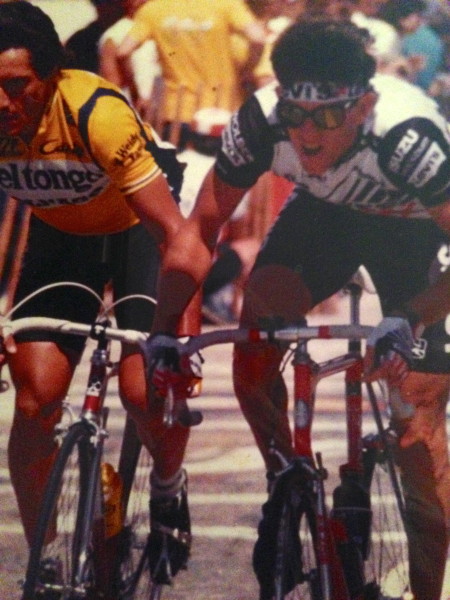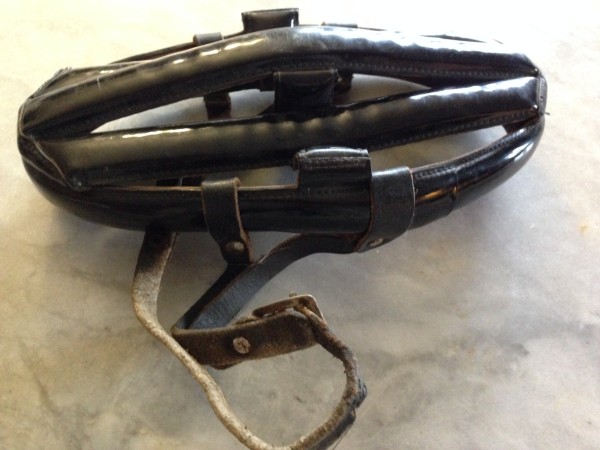I was on the USCF (before USAC) board of directors back in the 80’s. One board meeting, out of the blue, the CEO at the time, Dave Prouty, said that the organization was going to cease to exist because he couldn’t obtain insurance because our members didn’t have proper head protection. We were presented with really no option other than passing a hard helmet rule.
I wasn’t for it at all. Back then, you pretty much had to wear either a Bell V1 Pro or a German track helmet. Both were heavy and ugly. But, the way it was presented, there wasn’t going to be any bike racing without making it mandatory for all amateur riders to wear them.
I was riding for Levis at the time and Bell was eager to get into PRO cycling, so they sponsored us. Man, were those helmets huge and cumbersome. I’d been racing in a hairnet helmet so long that the Bell helmet felt like a brick on my head.
Anyway, pretty early in the season, we were at a circuit race in Castle Rock, Colorado and it started storming. Pretty soon it was hailing pretty good size hail. I just kept looking towards the ground and I could hear the ice popping off my helmet. I was thinking at the time that the helmet was much better for situations like this, than a hairnet.
In the Coor’s Classic and Professional races, we didn’t have to wear a helmet at all, and I usually didn’t. It took a while for the rest of the World to pass their helmet rules. There was a time that you didn’t have to wear your helmet when you were climbing, so in the Tour, etc., guys would take their helmets off when going uphill, and hang them on their handlebars or give them to their team cars.
Eventually, Jim Gentes came up with the idea for styrofoam helmets, Giro, and they got way lighter and more usable. And UCI made it mandatory for all riders to wear them all the time.
The weird twist to the story is the during the 2nd day of the board of director’s meeting, after we had already passed the hard helmet rule, a discussion came up on budget. I asked Dave Prouty how much money that we going to save with our new rule and he said that he hadn’t talked to any insurers about it, but was pretty sure that it was going to save us a bunch of money. So, he pretty much just made up the extinction of bike racing insurance story. I’m not sure what the reason for him to be so adamant about hard helmets, but I guess it worked out in the long run.

The first time I ever wore a hard helmet. Micheal Fatka, our team director, paid me somthing like $500 to wear one at Cyclocross Nationals in Plymouth, MA.







So did you beat Saronni for that prime? 🙂
From what’s written here, I don’t see where you can draw the conclusion that Prouty made the extinction justification up. The way I read the description, the insurers said they wouldn’t insure bike races without hard shell helmets at any cost, period. Based on that, Prouty pushed through the rule. Since the issue was whether insurance would be available not the cost differential, Prouty never discussed cost savings with the insurance companies.
Euro-Of course.
And Anthony-The situation was that Dave hadn’t talked to any insurance companies at all about the “issue”. Safety or cost.
Still have my hairnet buried in the closet, a Cinelli Alexi Grewal model.
I am not anti- or pro-mandatory helmets laws or rules. However, I would never leave on a ride without mine. I’ve destroyed three helmets. One of those incidents would have likely left me drooling and vegetative if alive at all after the accident. I would rather the helmet take a brunt of the force than my skull!
A bit of tangent here, but worth a read for background, context and politics of sport: David Prouty’s book, “In Spite of Us”.
http://www.amazon.com/In-Spite-Us-Education-Amateur/dp/0941950182/ref=sr_1_5?ie=UTF8&qid=1386007337&sr=8-5&keywords=in+spite+of+us
Just to be ridiculously clear,
There’s a minor difference to Dave not initiating a discussion with the insurance providers and the insurance providers telling him they won’t provide insurance without helmet rules. So, not only did Dave not bring it up, you are saying insurance company(ies) never discussed denying coverage to bicycle races/federation?
Got to agree with Channel Zero here: Prouty’s statements do mesh with what was happening at that time – the rise of lawsuits, liability and rising insurance costs. I’ve heard the 80s described as “the liability crisis” for insurance companies. Lots of lawsuits, in part made possible by several Supreme Court decisions. So Prouty may have gotten a clear message from the insurer, or a less-direct one (such as a mailing to policyholders). And if an insurance company says to me, “We won’t insure your house without smoke detectors,” and then I get smoke detectors, then I’ll still have to ask them how much I save. Knowing insurance companies, they then take three months to get back to you on your premium.
This goddamned helmet compulsorisation is the worst tragedy ever happened to cycling. So sad you can’t ride free in group rides anymore. IMHO that KIvilev dude did tons more damage to the sport than Mr Armstrong. Kinda put the lid on the whole scene.
Black socks are bad, but not even close as bad as helmets. A true cyclist should always wear white socks, black shorts and never ever be forced to wear a helmet.
Just talkin’ to the wind here, but I wonder if any money was passed under the table by any unnamed helmet makers……..
I had one of those Bell V1 Pros also. Gave it away as soon as the Giros came out.
Modern helmets are “almost” as good as riding helmet free.
.
For a while those helmets did more harm then good. Remember those Avenir helmets that were polystyrene and had the removable Lycra cover? Without plastic over the polystyrene – the helmet wouldn’t slide across asphalt. While your head might be protected against the impact; people had neck injuries from the sudden stop.
I remember Alexi Grewal at the Munsingwear Classic had taken a magic marker and drawn a skull on his polystyrene helmet. He also tied a pack of Marlboro cigarettes on the back of his helmet so the whole thing looked like those images you saw of troops wearing helmets like that in Viet Nam.
As an aside, I grew up ski racing and one of the only helmets that was available was a Bell. Bell had two versions in production – one that was motocross style with a full face and the other (which wasn’t as cool) without the full face. If you fell with that full face helmet and you were anywhere near soft snow- the full face would collect snow and make your neck snap back and forth as it drug along. If you could stand up after that – you then had to pull all the snow that got packed in there out as you were suffocating. Those helmets lasted about a season before they got pulled.
Brain trauma costs a !!!@#$ fortune. http://cyclingtips.com.au/2013/05/bike-helmets-an-emergency-doctors-perspective/
Don’t let the facts get in the way of a REALLY EXPENSIVE injury. Because it’s not like you pay for it right? Oh, that’s right, the rest of us pay for your stubborn death wish through higher insurance costs.
enjoyed the article. Reminds me I am still looking for one of those hairnets if anyone has one they want to part with. I used to have a brancale in the ’80s and they are hard to find